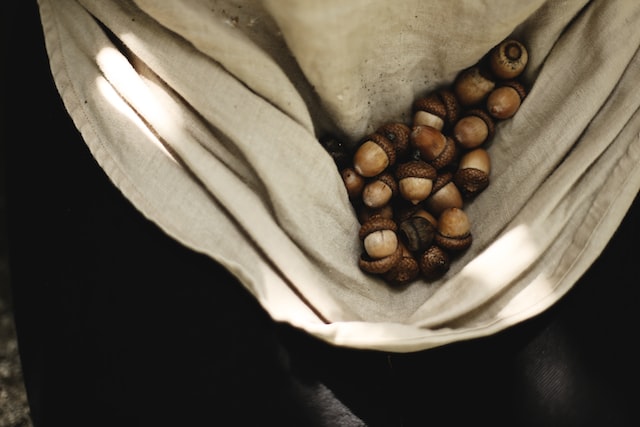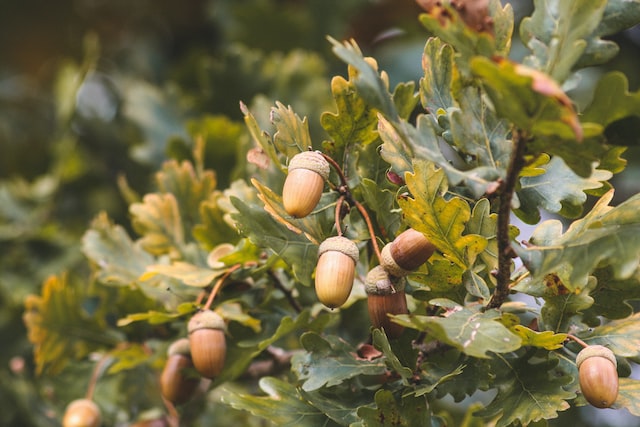The Art of Fragrance Ingredients
Oak: A Mighty and Versatile Symbol of Strength and Resilience
Introduction: Oak, with its mighty presence and versatile qualities, has been revered by civilizations and cultures throughout history. This magnificent tree holds significant symbolic and practical value, and various aspects of the oak tree have found their way into different aspects of human life. From inspiring perfumers with its woody fragrance to offering potential therapeutic properties in essential oils, oak's allure extends beyond its grandeur in forests. Additionally, its culinary uses, historical significance, and intriguing fun facts add to its charm. This essay delves into the captivating world of oak, encompassing its presence in perfumes, therapeutic oils, food, medicine, and uncovering some fascinating and fun facts about this majestic and resilient tree.
Symbolic Significance and Cultural Importance: The oak tree holds a prominent place in mythology, religion, and folklore. It has been revered as a symbol of strength, longevity, and resilience in various cultures. In ancient Greek mythology, the oak was associated with Zeus, the king of gods, representing power and wisdom. In Celtic beliefs, the oak was seen as a sacred tree, representing protection and connection to the natural world. The oak's association with strength and stability has made it a popular choice for national emblems and coats of arms in different countries.
Perfumes and Fragrance: While oak essential oil is not commonly available, perfumers may use oak moss absolute or oakwood accord to recreate the woody and earthy fragrance of oak. Oak moss absolute is derived from certain species of lichen, providing a deep and rich aroma with mossy undertones. The fragrance of oak is often used in perfumery to add a sense of depth and character to compositions, evoking a connection to nature and a touch of sophistication.
Therapeutic Oils and Aromatherapy: Oak essential oil is not widely used in aromatherapy; however, oak wood chips and extracts are occasionally used for their potential therapeutic properties. Oak wood extracts may have a grounding and calming effect on the mind, making them valuable in relaxation and meditation practices. Additionally, certain traditional medicine systems have used oak bark and leaves for their potential astringent and anti-inflammatory properties.
Culinary Delights: Oak is not typically used as a culinary ingredient, but its acorns have historically been consumed in some cultures after processing to remove bitterness and toxins. Acorns were used as a food source by various indigenous communities, who developed methods to leach out the bitter tannins and create nutritious flour for baking.
Medicinal Applications: Oak has been used in traditional medicine systems for various purposes. Oak bark has been utilized as an astringent to help with diarrhea, wounds, and skin conditions. Additionally, certain medicinal teas and tinctures made from oak leaves or bark have been used for their potential health benefits.
Fun and Crazy Facts:
Oak, with its might and versatility, is a symbol of strength, resilience, and enduring beauty. From its cultural and symbolic significance to its occasional use in perfumes and therapeutic oils, oak continues to inspire awe and admiration in the hearts of people worldwide. As we admire the majestic presence of oak trees and the myriad ways in which they enrich our lives, we are reminded of the importance of preserving and honoring the natural wonders of our world.
Introduction: Oak, with its mighty presence and versatile qualities, has been revered by civilizations and cultures throughout history. This magnificent tree holds significant symbolic and practical value, and various aspects of the oak tree have found their way into different aspects of human life. From inspiring perfumers with its woody fragrance to offering potential therapeutic properties in essential oils, oak's allure extends beyond its grandeur in forests. Additionally, its culinary uses, historical significance, and intriguing fun facts add to its charm. This essay delves into the captivating world of oak, encompassing its presence in perfumes, therapeutic oils, food, medicine, and uncovering some fascinating and fun facts about this majestic and resilient tree.
Symbolic Significance and Cultural Importance: The oak tree holds a prominent place in mythology, religion, and folklore. It has been revered as a symbol of strength, longevity, and resilience in various cultures. In ancient Greek mythology, the oak was associated with Zeus, the king of gods, representing power and wisdom. In Celtic beliefs, the oak was seen as a sacred tree, representing protection and connection to the natural world. The oak's association with strength and stability has made it a popular choice for national emblems and coats of arms in different countries.
Perfumes and Fragrance: While oak essential oil is not commonly available, perfumers may use oak moss absolute or oakwood accord to recreate the woody and earthy fragrance of oak. Oak moss absolute is derived from certain species of lichen, providing a deep and rich aroma with mossy undertones. The fragrance of oak is often used in perfumery to add a sense of depth and character to compositions, evoking a connection to nature and a touch of sophistication.
Therapeutic Oils and Aromatherapy: Oak essential oil is not widely used in aromatherapy; however, oak wood chips and extracts are occasionally used for their potential therapeutic properties. Oak wood extracts may have a grounding and calming effect on the mind, making them valuable in relaxation and meditation practices. Additionally, certain traditional medicine systems have used oak bark and leaves for their potential astringent and anti-inflammatory properties.
Culinary Delights: Oak is not typically used as a culinary ingredient, but its acorns have historically been consumed in some cultures after processing to remove bitterness and toxins. Acorns were used as a food source by various indigenous communities, who developed methods to leach out the bitter tannins and create nutritious flour for baking.
Medicinal Applications: Oak has been used in traditional medicine systems for various purposes. Oak bark has been utilized as an astringent to help with diarrhea, wounds, and skin conditions. Additionally, certain medicinal teas and tinctures made from oak leaves or bark have been used for their potential health benefits.
Fun and Crazy Facts:
- Majestic Oak Trees: Oak trees are known for their longevity and can live for several centuries, with some even surviving for over a thousand years.
- Oaks and Literature: The oak tree has been celebrated in literature, appearing in various poems, novels, and works of art as a symbol of strength and wisdom.
- Oak's Role in History: Oak wood has been used for shipbuilding, construction, and furniture making for centuries due to its strength and durability.
- Oak Galls and Ink: Historically, oak galls, produced by certain wasps on oak trees, were used in the production of ink due to their high tannin content.
- Oak's Ecological Importance: Oak trees support a diverse range of wildlife, providing habitat and food sources for various animal species.
Oak, with its might and versatility, is a symbol of strength, resilience, and enduring beauty. From its cultural and symbolic significance to its occasional use in perfumes and therapeutic oils, oak continues to inspire awe and admiration in the hearts of people worldwide. As we admire the majestic presence of oak trees and the myriad ways in which they enrich our lives, we are reminded of the importance of preserving and honoring the natural wonders of our world.
To experience augmented reality, please open the Facebook-app using QR code and point to the image below
Exploring Oak Woody Aromatics
Oak is a type of tree that belongs to the genus Quercus in the family Fagaceae. There are over 600 species of oak trees found throughout the world, with many of them being native to the Northern Hemisphere. Oak trees are known for their strong and durable wood, which is often used in construction, furniture making, and flooring. Oak trees are also known for their acorns, which are a food source for wildlife and were also an important food source for humans in the past. Oak trees can live for hundreds of years and can grow to be very large. The leaves of oak trees are typically lobed and the bark is usually rough and deeply grooved. Oak trees are also considered to be important ecologically, providing habitats for many species of birds, insects, and other animals.
Crafting Perfumes with Natural Extracts
Oak trees have a long and rich history, dating back to ancient times. They have been revered and respected by cultures around the world for thousands of years.
In ancient Greece, oak trees were sacred to Zeus, the king of the gods, and were believed to be the home of his lightning bolts. Oak leaves and acorns were also used to decorate the heads of Olympic champions and were said to have healing powers.
In ancient Rome, oak trees were sacred to Jupiter, the king of the gods, and were often planted around temples and other religious sites. Oak wood was also highly valued for its strength and durability and was used to construct ships and buildings.
In the Celtic culture, oak trees were considered to be sacred and were often associated with strength, wisdom, and power. Oak leaves and acorns were also used in druidic rituals.
In Norse mythology, the oak was sacred to Thor and was considered to be a symbol of strength, endurance, and stability.
In medieval Europe, oak trees were believed to have protective powers and were often planted near homes and villages to ward off evil spirits. Oak wood was also highly valued for its strength and durability and was used to construct houses, ships, and other buildings.
Throughout history, Oak has been used for many different purposes, such as: construction, shipbuilding, furniture making, and flooring, in addition to its symbolic and cultural significance.
In ancient Greece, oak trees were sacred to Zeus, the king of the gods, and were believed to be the home of his lightning bolts. Oak leaves and acorns were also used to decorate the heads of Olympic champions and were said to have healing powers.
In ancient Rome, oak trees were sacred to Jupiter, the king of the gods, and were often planted around temples and other religious sites. Oak wood was also highly valued for its strength and durability and was used to construct ships and buildings.
In the Celtic culture, oak trees were considered to be sacred and were often associated with strength, wisdom, and power. Oak leaves and acorns were also used in druidic rituals.
In Norse mythology, the oak was sacred to Thor and was considered to be a symbol of strength, endurance, and stability.
In medieval Europe, oak trees were believed to have protective powers and were often planted near homes and villages to ward off evil spirits. Oak wood was also highly valued for its strength and durability and was used to construct houses, ships, and other buildings.
Throughout history, Oak has been used for many different purposes, such as: construction, shipbuilding, furniture making, and flooring, in addition to its symbolic and cultural significance.
The Elegance of Oak in Perfumery
Oak trees have been a popular subject in literature, painting, and art throughout history.
In literature, oak trees are often used as symbols of strength, endurance, and wisdom. They are often associated with natural beauty and wildness and are often used to evoke a sense of nostalgia and longing for a simpler, more natural way of life. Oak trees have also been used as a metaphor for the resilience of the human spirit and the ability to overcome adversity.
In painting and art, oak trees are often depicted as grand and majestic, standing as a symbol of the natural world's beauty and power. They are also often used to convey a sense of timelessness and continuity, as they can live for hundreds of years and are deeply rooted in the earth.
In many cultures and art forms, the oak tree is frequently used as a symbol of strength, endurance and stability. The tree is often used to symbolize the continuation of life and the continuity of tradition. The tree is also used to represent the natural beauty of the forest and the power of nature.
Also, Oak wood is a popular medium for carving and sculpture. Oak figures and sculptures have been found in many cultures throughout history and are considered to be some of the most beautiful and enduring works of art.
In conclusion, Oak trees and its symbolism have been present in art, literature and culture for centuries, evoking feelings of strength, endurance, and wisdom. As well as, Oak is a symbol of natural beauty and the continuity of tradition.
In literature, oak trees are often used as symbols of strength, endurance, and wisdom. They are often associated with natural beauty and wildness and are often used to evoke a sense of nostalgia and longing for a simpler, more natural way of life. Oak trees have also been used as a metaphor for the resilience of the human spirit and the ability to overcome adversity.
In painting and art, oak trees are often depicted as grand and majestic, standing as a symbol of the natural world's beauty and power. They are also often used to convey a sense of timelessness and continuity, as they can live for hundreds of years and are deeply rooted in the earth.
In many cultures and art forms, the oak tree is frequently used as a symbol of strength, endurance and stability. The tree is often used to symbolize the continuation of life and the continuity of tradition. The tree is also used to represent the natural beauty of the forest and the power of nature.
Also, Oak wood is a popular medium for carving and sculpture. Oak figures and sculptures have been found in many cultures throughout history and are considered to be some of the most beautiful and enduring works of art.
In conclusion, Oak trees and its symbolism have been present in art, literature and culture for centuries, evoking feelings of strength, endurance, and wisdom. As well as, Oak is a symbol of natural beauty and the continuity of tradition.
Fun facts about oak trees:
- Oak trees can live for hundreds of years, with some species living for over 1000 years.
- Oak trees are known for their acorns, which are a food source for wildlife such as deer, squirrels, and birds.
- Oak wood is known for its strength and durability, making it a popular choice for construction, furniture making, and flooring.
- Oak trees are also known for their deep roots, which can help to prevent soil erosion and provide stability for the surrounding ecosystem.
- The Oak tree is the national tree of many countries including the United States, Germany, and England.
- Oak trees are also a popular choice for bonsai trees, which are miniature versions of the tree grown in small containers.
- Oak bark has been used for tanning leather for centuries.
- Oak wood is also used to smoke meats and cheeses, giving them a unique flavor.
- Oak tree is also a significant tree in many cultures and religions, it is sacred to many gods and goddesses, including Zeus and Jupiter, and is considered to have protective powers.
- The Oak tree has been used to make wine barrels for centuries, giving the wine a unique flavor and aroma.
Sourcing the Finest Perfume Ingredients
Oak wood does not have a strong or distinct scent, it is often described as a mild, slightly woodsy smell. The scent of oak wood is subtle and can be difficult to detect, it may be more noticeable when the wood is being worked or is exposed to heat. Oak wood is not commonly used in perfumery, but it has been used to make incense and is sometimes used in essential oils.
Oakmoss and oakmoss absolute, which is used in perfumery as a fixative and to add a woody, mossy and earthy scent to perfumes. The oakmoss is a lichen (not a moss) that grows on oak trees, it is collected in the wild, and is used in perfumery to add a woody, mossy and earthy scent to perfumes. It is an allergen for some people. This is covered as a separate topic in next blog.
In conclusion, Oak wood does not have a strong or distinct scent, but Oakmoss is used in perfumery to add a woody, mossy and earthy scent to perfumes.
Oakmoss and oakmoss absolute, which is used in perfumery as a fixative and to add a woody, mossy and earthy scent to perfumes. The oakmoss is a lichen (not a moss) that grows on oak trees, it is collected in the wild, and is used in perfumery to add a woody, mossy and earthy scent to perfumes. It is an allergen for some people. This is covered as a separate topic in next blog.
In conclusion, Oak wood does not have a strong or distinct scent, but Oakmoss is used in perfumery to add a woody, mossy and earthy scent to perfumes.
Here are some examples of perfumes that have "Oak" in their scent:
- "Oak" by Comme des Garcons
- "Oak Wood" by Lush
Join Scentopia, Sentosa's latest tourist attraction wonderful orchid scent crafting, fragrance tour, bridal shower or corporate team building which includes perfume making onsite and offsite, beach activities and more. We also serve primary school learning journey, secondary students and pupil on industrial excursions. Know more about our orchids perfume bar or therapeutic orchid scents and other wellness aromas. Conatct Perfume workshop or book a scent crafting session here.






